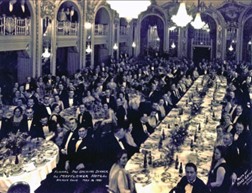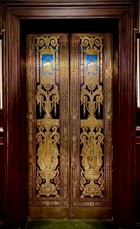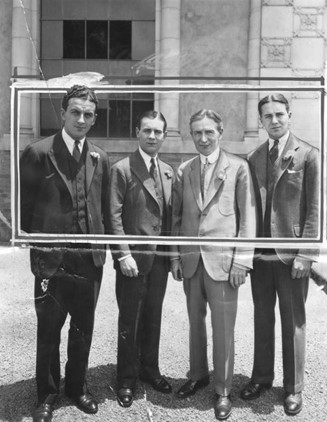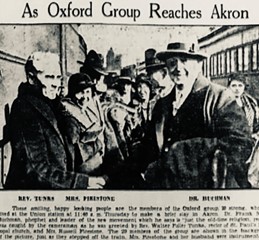The Mayflower Hotel
“One dismal afternoon, he paced a hotel lobby wondering how his bill was to be paid. At one end of the room stood a glass covered directory of local churches. Down the lobby a door opened into an attractive bar.” (Alcoholics Anonymous, 4th ed., pg. 155)

The empty promise of ease and comfort beckoned to Bill. It floated on the carefree chatter drifting lazily from the Parisian Bar of Akron’s newest and grandest hotel, The Mayflower.
The fact that there was a hotel at all, funded by a special allocation earmarked years before, was a miracle in and of itself in the middle of the Great Depression. She opened in May of 1931 to great fanfare, including newspaper headlines, a grand pre-opening dinner, and rose petals dropped from the Goodyear blimp.

All the pomp was in stark contrast to the world outside of the hotel lobby where Bill paced on Mother’s Day weekend in 1935. On Main Street, and Main Streets across the country, stretched soup kitchen lines of the jobless hungry for food. The Mayflower’s luxury and the happy voices in the bar were a thin veil over the desperation gripping the nation.
An otherwise unremarkable elevator lobby became the stage for a vital moment in the history of the Fellowship of Alcoholics Anonymous, a moment repeated in the individual stories of countless alcoholics since – it was a turning point.
Bill hesitated as he stood before those elevator doors. Etched on the doors was a ship with billowing sails – the Mayflower, a symbol of hope and new beginnings.

A call to a local minister had led to another call and finally to the number in his hand.
From the failed venture that brought him to Akron, he knew the name Seiberling. Bill knew it was the name behind the Goodyear Tire and Rubber Company, the largest of three companies that made Akron the “Rubber City” and seat of the world’s tire industry.
Bill likely did not know that where he stood was the site of another key link in the unfolding chain of events that would lead to his meeting with Dr. Bob the following evening. He did not know that Providence had made a path.

In 1932, Russell Firestone was another rum hound out of options. “Bud” was the proverbial prodigal son of Harvey Firestone, the founder of Firestone Tire & Rubber, a major competitor to Goodyear.
Unable to stay sober, Bud attended an Oxford Group convention in Denver with his friend and longtime Firestone employee, Jimmy Newton. On the journey home, Bud had a chance meeting with Reverend Sam Shoemaker, a prominent Oxford Grouper. Shortly thereafter, through application of the group’s principles, Bud got sober.
Rejoicing at the return of his son from the brink of alcoholic destruction, Harvey wanted to celebrate. The gratitude of a loving father led to a personal invitation for the founder of the Oxford Group, Frank Buchman, to lead a mission to Akron.
In January 1933, Buchman and his entourage arrived in Akron and were greeted at the train station by a delegation of notable citizens, including Reverend Walter Tunks. Years later when Tunks answered his phone on a Saturday afternoon and heard Bill’s plea, the minister understood and knew what to do.
The Mayflower was the venue for the Oxford Group’s “house party,” a term used by Oxford Groupers to describe their missions. All of Akron turned out for the week of meetings and revivals. Be it an estranged wife of a millionaire or a surgeon under the lash of alcoholism, they were people who normally would not mix.

Akron Beacon Journal
As a keynote speaker at the final meeting, Bud identified as an alcoholic and gave witness to his recovery. Buchman’s visit and Bud’s testimony link Akron (and the Mayflower Hotel) with the spiritual recovery movement years before the founding of AA. Akron was now fertile soil for what would eventually grow into a worldwide fellowship of alcoholics.
But for Bill, standing on a razor’s edge, that would have been inconceivable. It was about survival. He found a phone and called the number given to him by Norman Shepherd.
“Hello, I’m a rum hound from New York and I’m looking for a drunk to help.”

In the wake of the Oxford Group’s visit, the meetings continued at homes across Akron. Moved by what she had heard during Buchman’s stay, Anne began frequenting these small gatherings. She eventually enticed Dr. Bob to join with the aid of a new friend, Henrietta Seiberling.
“Henry” later orchestrated the intervention for Bob in the weeks prior to Bill’s arrival. She answered the phone when Bill called on that dismal afternoon. And she arranged the first meeting between Bill and Dr. Bob. The spark was struck.
In the years to come, the numerous Oxford Group meetings that began with Buchman’s ‘house party’ at the Mayflower provided an ad hoc network of meetings for Akron and Cleveland alcoholics seeking to recover. The Oxford Group principles used by Bud to recover became the basis for the Twelve Steps.
The Mayflower Hotel closed 40 years after it first opened and has changed hands many times in the intervening years; little is left of its former glory. Like Dr. Bob’s Home, it is listed in the National Register of Historic Places. It currently is a private, senior-assisted living community and is currently not open to the public.